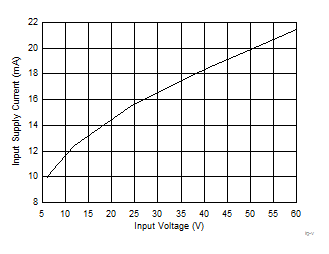SNVSBV9 January 2021 LMR36015S
PRODUCTION DATA
- 1 Features
- 2 Applications
- 3 Description
- 4 Revision History
- 5 Description (continued)
- 6 Device Comparison Table
- 7 Pin Configuration and Functions
- 8 Specifications
- 9 Detailed Description
-
10Application and Implementation
- 10.1 Application Information
- 10.2
Typical Application
- 10.2.1
Design 1: Low Power 24-V, 1.5-A PFM Converter
- 10.2.1.1 Design Requirements
- 10.2.1.2
Detailed Design Procedure
- 10.2.1.2.1 Custom Design With WEBENCH Tools
- 10.2.1.2.2 Choosing the Switching Frequency
- 10.2.1.2.3 Setting the Output Voltage
- 10.2.1.2.4 Inductor Selection
- 10.2.1.2.5 Output Capacitor Selection
- 10.2.1.2.6 Input Capacitor Selection
- 10.2.1.2.7 CBOOT
- 10.2.1.2.8 VCC
- 10.2.1.2.9 CFF Selection
- 10.2.1.2.10 Maximum Ambient Temperature
- 10.2.2 Application Curves
- 10.2.3 Design 2: High Density 24-V, 1.5-A FPWM Converter
- 10.2.1
Design 1: Low Power 24-V, 1.5-A PFM Converter
- 10.3 What to Do and What Not to Do
- 11Power Supply Recommendations
- 12Layout
- 13Device and Documentation Support
- 14Mechanical, Packaging, and Orderable Information
Package Options
Mechanical Data (Package|Pins)
- RNX|12
Thermal pad, mechanical data (Package|Pins)
- RNX|12
Orderable Information
10.2.3.3 Application Curves

| VOUT = 5 V | 1000 kHz |

| VOUT = 5 V | 1000 kHz |

| VOUT = 5 V | IOUT= 0 A | RFBT= 100 kΩ |

| VOUT = 5 V | 1000 kHz | ILOAD= 0 A – 0.75 A |
| Slew Rate = 1 µs/A |

| VOUT = 5 V | 1000 kHz |

| VOUT = 5 V | 1000 kHz |

| VOUT = 5 V | 1000 kHz |

| VOUT = 5 V | Slew Rate = 1 µs/A | 1000 kHz | |
| ILOAD= 0 A – 1.5 A |